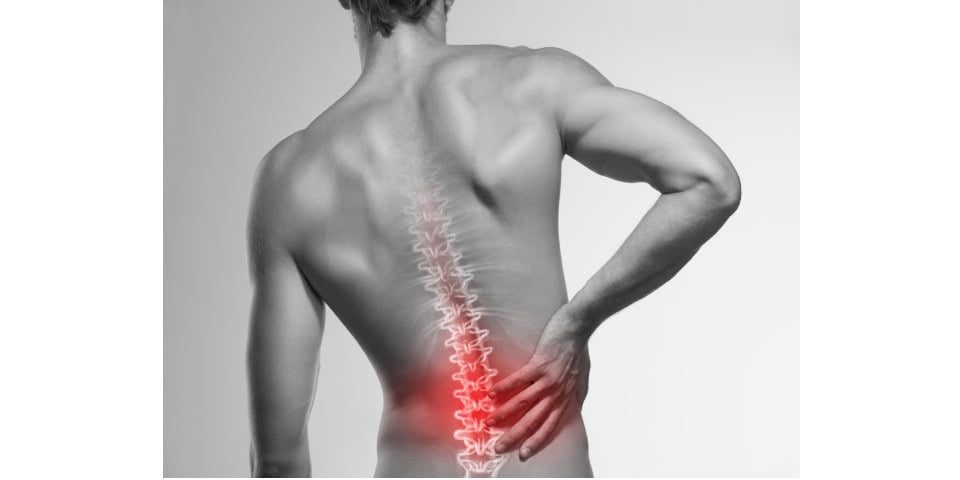An estimated one in six Australians reported having back problems in 2017–18, according to the Australian Institute of Health and Welfare.1
In 2018–19, more money was spent on managing musculoskeletal disorders, including back problems, than any other category of disease, condition or injury in Australia.2
Back pain is a complex condition with a variety of causes, including muscle strain, injury, poor posture, and chronic conditions such as arthritis.
The type and severity of the pain can vary, with some individuals experiencing mild discomfort and others suffering from debilitating pain that affects their ability to perform everyday activities.
Anatomy
Understanding the anatomy of the back plays a crucial role in obtaining an accurate diagnosis, and the appropriate management of back pain.
The back is supported by the spinal column, also known as the vertebral column, a series of 33 individual bones, stacked one on top of the other.
The vertebrae are divided into five regions: cervical, thoracic, lumbar, sacral and coccygeal.
Spaces between the bones are maintained by spongy ‘shock absorbing’ cushion-like pads of cartilage called intervertebral discs.
Bands of tissue known as ligaments and tendons hold the vertebrae in place and attach the muscles of the back to the spinal column.
The muscles, ligaments, tendons and discs protect the spinal cord while allowing movement in different directions.
Injury, wear and tear, and ageing are all common factors that can put a strain on the structure of the back.
According to the Australian Physiotherapy Association, the most common type of back pain in Australia is non-specific low back pain.3,4
This type of back pain is defined as pain and discomfort in the lower back region that cannot be attributed to a specific cause, such as a herniated disc or a spinal fracture.
Back-saving tips for patients
Promoting back health is one of the most important parts of addressing back pain.
Encouraging patients to take care of their back can help prevent the onset of pain or reduce the severity of existing pain.
Based on the recommendations from peer-reviewed journals, patients are encouraged to exercise regularly, maintain a healthy weight, use proper lifting techniques, practise good posture and take breaks from prolonged sitting.5,6
Exercise regularly. Physical activity can help improve back strength and flexibility, reducing the likelihood of muscle strains and injuries. Encourage patients to engage in low-impact activities such as walking, swimming and yoga, and to consult with their healthcare provider before beginning a new exercise program.
Lift properly. Lifting heavy objects incorrectly can strain the back muscles and cause injury. Teach patients to lift with their legs, keeping their back straight, and to avoid twisting while lifting. WorkSafe Victoria provides guidance on safe manual handling techniques, including proper lifting technique, avoiding twisting or bending, and using mechanical aids when appropriate.7
Maintain good posture. This reduces pressure on the spine, promotes proper alignment and improves muscle balance in the back, neck and shoulders. Encourage patients to practise good posture by sitting up straight and keeping their shoulders back when standing or walking.
References
- Australian Institute of Health and Welfare. 2021. ‘Back problems’. aihw.gov.au/reports/australias-health/health-of-people-with-disability
- Australian Institute of Health and Welfare. ‘Disease expenditure in Australia 2018–19’. Canberra: AIHW, 2021. aihw.gov.au/reports/health-welfare-expenditure/disease-expenditure-australia/contents/australian-burden-of-disease-groups
- Safe Work Australia. 2019. ‘Work-related musculoskeletal disorders profile’. safeworkaustralia.gov.au/resources-and-publications/reports/work-related-musculoskeletal-disorders-australia-2019
- Australian Physiotherapy Association. 2022. ‘Better care for back pain’. australian.physio/inmotion/better-care-back-pain
- Franzco J, Macedo L. (2006). ‘Exercise for chronic low back pain: a randomised controlled trial in the community-based primary healthcare setting’. Rehabilitation Medicine Journal of Australia, 2016; 30 (3), 93-98.
- Abdulraheem KA, Alrawaji FN, Alghadir AH. ‘The effectiveness of a specific exercise program on pain and disability in patients with chronic low back pain: A randomised controlled trial’. Journal of Back and Musculoskeletal Rehabilitation, 2020 Jan 1; 33 (1): 61-70.
- WorkSafe Victoria. Manual handling. [Accessed 21/4/23]. worksafe.vic.gov.au/
This feature was written by Irene Vergos, a registered pharmacist and Professional Services Manager at Direct Chemist Outlet.
This feature was originally published in the June issue of Retail Pharmacy magazine.




